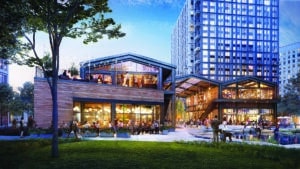
Cambridge Crossing’s retail space includes a stand-alone building called The Shed that will contain three restaurant concepts, including a roof deck overlooking The Common outdoor amenity space including a water garden and picnic grove. Image courtesy of Steelblue and DivcoWest
The pandemic has accelerated the reshaping of the retail industry and how malls will position themselves moving forward. According to data from research firm REIS, the national mall vacancy rate hit a historic high of 9.8 percent in early September.
Owners and developers are faced with the challenge of big-box retailers vacating their anchor space to try and stay solvent, without tenants who are immediately able to fill it. Retail has always found a way to bounce back, and as developers and owners look to the future and how to create a successful property, two key areas of focus should be diversification and customer safety.
Developers have an opportunity to get creative and expand their offerings. Prior to COVID-19, we saw more mall owners mirroring lifestyle centers by incorporating storefront medical, wellness, fitness centers, offices, restaurants and residences into their portfolios. We see this trend continuing and, amidst a health care crisis, we see the demand for storefront medical and wellness centers increasing.
Local Projects Lead the Way
In New England and Massachusetts in particular, there are key examples of diversification. Cambridge Crossing, currently under way in East Cambridge, is combining commercial, retail and residential space alongside public and green space and science and tech facilities to create an all-encompassing destination for consumers. Patriot Place in Foxborough recently added Brigham Health and Brigham and Women’s/Mass General Health Care Centers to round out its tenant roster, which had previously been retail and hospitality-focused.
With the lasting effects of the stay-at-home orders shifting even more consumer spending online, it is critical for owners and developers to take stock of their tenants and diversify their properties, providing a multitude of reasons for consumers to leave their homes for mixed-use destinations. While one specific tenant may drive a consumer to a mall, its variety of offerings will lead them to explore and spend more time there. These traditional malls also have an advantage of prime real estate locations, oftentimes right off major thoroughfares that are densely populated with households with disposable income.
With all this in mind, we anticipate properties parceling out large, anchor tenant spaces to create real estate for multiple new, varied tenants, cultivating a live-work-play, town square feel.
Also key to a successful development is the caliber and quality of the tenants. Owners should look for tenants that create an experience for their customers that can’t be replicated online to drive continued, repeat traffic. This will in turn make the mall a destination, rather than a quick pit stop, and increase dwell time and ultimately, spending. It’s important for developers to also look for tenants that translate seamlessly across channels—from web site to social media to brick-and-mortar – creating multiple streams for revenue that gives them a competitive edge.
Maximizing Safety With Physical Updates
Appealing tenants aren’t anything without consumer trust and confidence, so mall owners and developers need to ensure their mitigation strategies provide customers – and tenants – reassurance and transparency that they are in a clean, safe space.

Shawn Taylor
This comes from the implementation of minor refreshes to increase safety measures, like adding plexiglass, reducing surface areas and integrating touchless technology, such as QR code systems, to major renovations to include more open air spaces and less indoor common areas. The health and safety of both customers and employees must remain a top priority.
Working with both landlords and brands, Shawmut has a unique perspective into the future of malls and their repositioning. Owners and developers need to envision their space as a truly mixed-use destination that forges a synergy between landlord, tenant and customer in order to keep pace with the ever-evolving industry.
Tenant diversification and customer safety are pivotal for mall properties now and in the post-coronavirus world – the pent-up demand for socialization will prove beneficial for owners and developers that act now to position their properties as go-to gathering destinations known for variety and safety.
Shawn Taylor is a senior director at Boston-based Shawmut Design and Construction.




 |
| 
